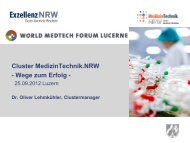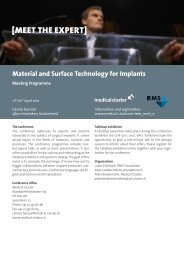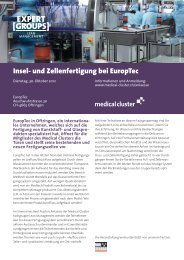[MEET THE EXPERT] - Medical Cluster
[MEET THE EXPERT] - Medical Cluster
[MEET THE EXPERT] - Medical Cluster
Sie wollen auch ein ePaper? Erhöhen Sie die Reichweite Ihrer Titel.
YUMPU macht aus Druck-PDFs automatisch weboptimierte ePaper, die Google liebt.
Formal Objection against ISO standards and<br />
potential consequences for MD manufacturers<br />
Orlando R. Antunes, Thommen <strong>Medical</strong> AG, Waldenburg<br />
INTRODUCTION: The principle of using<br />
harmonized standards is as old as the “New<br />
Approach” concept of the European Union.<br />
Harmonized Standards are common used<br />
instruments in order to achieve the presumption of<br />
conformity and to prove compliance and<br />
achievement of essential requirements given on the<br />
directives.<br />
On November 15 th 2010 the European<br />
Commission issued a formal objection against<br />
11 international recognized and harmonized<br />
standards. The official explanation is that the<br />
European Commission is concerned that these<br />
standards do not sufficiently cover the essential<br />
requirements of the applicable medical devices<br />
directives that are claimed to be covered in the<br />
standards' annexes Z. Among others standards, a<br />
very important standard used by a broad range of<br />
medical devices manufacturers (EN ISO<br />
14971:2009 - <strong>Medical</strong> devices - Application of risk<br />
management to medical devices) was included on<br />
the list. Moreover, on February 10 th 2011, the<br />
Swedish Competent Authority also submitted a<br />
formal objection to another inalienable<br />
standard. This time the EN ISO 13485:2003 –<br />
<strong>Medical</strong> Devices - Quality Management systems -<br />
Requirements for Regulatory Purposes was on the<br />
focus of the international authorities.<br />
These initiatives at European level could represent<br />
an important challenge for the medical devices<br />
industry if no consensus is found in a timely<br />
manner. Moreover, it could also jeopardize the<br />
entire concept of harmonized standards, which is<br />
well implemented and adopted in Europe.<br />
CONCEPTS: Since 1987 some 25 European<br />
Directives have been adopted under the "New<br />
Approach", according to which European<br />
Standards are needed to "complete" each directive.<br />
Among these directives, the directives covering<br />
active and non-active implantable medical devices<br />
(93/42/EEC, 90/385/EEC) as well as in vitro<br />
diagnostic medical devices (98/79/EC) can be<br />
found.<br />
The New Approach is based on the following<br />
principles:<br />
� Essential health and safety requirements for<br />
certain products requiring a particularly high<br />
level of safety are defined in the directives.<br />
� The corresponding technical specifications<br />
giving detail to these essential requirements are<br />
to be drawn up by the European Committees<br />
(CEN, CENELEC and ETSI) in the form of<br />
harmonized European Standards, following a<br />
mandate issued by the European Commission<br />
and/or the EFTA secretariat.<br />
� These European Standards are to be adopted as<br />
national standards in each EU and EFTA<br />
member country. Standards are not<br />
mandatory; rather, their use is voluntary. In<br />
principle an alternative means of proving<br />
compliance with the safety requirements of<br />
the directives is possible.<br />
The harmonized standards grant the presumption<br />
of conformity to the essential requirements of<br />
the new approach directives applied to that<br />
standard. Detailed information on what requirements<br />
of the directives are covered by the<br />
standards is given on each harmonized standard on<br />
their annexes ZA, ZB and ZC. The harmonization<br />
comes into effect once these standards are listed<br />
and published in the official gazette in relation<br />
with the specified directive. An updated list about<br />
references for every directive is available on:<br />
http://ec.europa.eu/enterprise/policies/europeanstandards/documents/harmonised-standardslegislation/list-references/index_en.htm<br />
DISCUSSION & CONCLUSIONS: The last developments<br />
show that the European Commission is<br />
willing to reconsider the deharmonization of the<br />
standards, if the Z Annexes - after being amended -<br />
provide accurate information about the coverage of<br />
the Essential Requirements of the directives. The<br />
key element for the Z Annexes is to indicate which<br />
essential requirements or parts of essential requirements<br />
are covered. The standards technical committees<br />
involved are now working on the amendment<br />
of these Annexes. At latest by mid 2011 the<br />
new drafts should be submitted to the CEN-CEN-<br />
ELEC Management Centre (CCMC) for adoption.<br />
38


![[MEET THE EXPERT] - Medical Cluster](https://img.yumpu.com/4254707/38/500x640/meet-the-expert-medical-cluster.jpg)
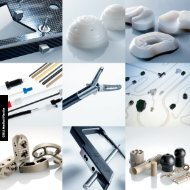
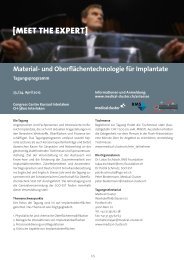

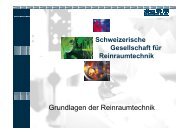
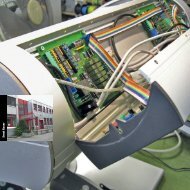
![[MEET THE EXPERT] - Medical Cluster](https://img.yumpu.com/8021008/1/184x260/meet-the-expert-medical-cluster.jpg?quality=85)

